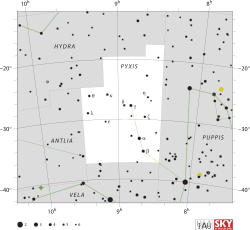Beta Pyxidis
Beta Pyxidis (Beta Pyx, β Pyxidis, β Pyx) is a double star[3] located in the southern constellation Pyxis. It has an apparent visual magnitude of 3.954, making it the second brightest star in that faint constellation.
 | |
| Observation data Epoch J2000 Equinox J2000 | |
|---|---|
| Constellation | Pyxis |
| Right ascension | 08h 40m 06.14363s[1] |
| Declination | –35° 18′ 30.0″[1] |
| Apparent magnitude (V) | 3.954[2] |
| Characteristics | |
| Spectral type | G7Ib-II[3] |
| U−B color index | +0.646[2] |
| B−V color index | +0.935[2] |
| Astrometry | |
| Radial velocity (Rv) | –13.4[4] km/s |
| Proper motion (μ) | RA: +9.84[1] mas/yr Dec.: –20.80[1] mas/yr |
| Parallax (π) | 7.84 ± 0.19[1] mas |
| Distance | 420 ± 10 ly (128 ± 3 pc) |
| Absolute magnitude (MV) | –0.78[5] |
| Details | |
| Radius | 28[6] R☉ |
| Surface gravity (log g) | 3.73±0.27[7] cgs |
| Temperature | 5,590±168[7] K |
| Metallicity [Fe/H] | −0.06±0.13[7] dex |
| Rotational velocity (v sin i) | 11.8[8] km/s |
| Other designations | |
| Database references | |
| SIMBAD | data |
Based upon parallax measurements, the star is an estimated 420 light-years (128 parsecs) from the Earth.[1] The spectrum matches a bright giant or supergiant star of stellar classification G7Ib-II. The interferometer-measured angular diameter of this star is 2.05 ± 0.14 mas.[9] At its estimated distance, this yields a physical size of about 28 times the radius of the Sun.[6] The effective temperature of the star's outer envelope is about 5,400 K, giving it the characteristic yellow hue of a G-type star.[10][11]
Beta Pyxidis has an unusually high rate of spin for an evolved star of this type, showing a projected rotational velocity of 11.8 km/s. One possible explanation is that it may have engulfed a nearby giant planet, such as a hot Jupiter.[8]
In 2010, the star was among a survey of massive, lower effective temperature supergiants in an attempt to detect a magnetic field. This star may have a longitudinal magnetic field with a strength of less than a Gauss.[12] It is a young disk star system with space velocity components, [U, V, W] = [–11.0, +11.8, –2.2] km/s.[5] There is a magnitude 12.5 optical companion, located at an angular separation of 12.7 arcseconds and a position angle of 118° as of the year 1943.[13]
Naming
In Chinese, 天狗 (Tiān Gǒu), meaning Celestial Dog, refers to an asterism consisting of β Pyxidis, e Velorum, f Velorum, α Pyxidis, γ Pyxidis and δ Pyxidis. Consequently, β Pyxidis itself is known as 天狗四 (Tiān Gǒu sì, English: the Fourth Star of Celestial Dog.)[14]
References
- van Leeuwen, F. (November 2007). "Validation of the new Hipparcos reduction". Astronomy and Astrophysics. 474 (2): 653–664. arXiv:0708.1752. Bibcode:2007A&A...474..653V. doi:10.1051/0004-6361:20078357.
- Gutierrez-Moreno, Adelina; et al. (1966). "A System of photometric standards". 1. Publicaciones Universidad de Chile, Department de Astronomy: 1–17. Bibcode:1966PDAUC...1....1G. Cite journal requires
|journal=(help) - "bet Pyx -- Star in double system". SIMBAD. Centre de Données astronomiques de Strasbourg. Retrieved 2009-04-15.
- Evans, D. S. (June 20–24, 1966). "The Revision of the General Catalogue of Radial Velocities". Proceedings from IAU Symposium no. 30, Determination of Radial Velocities and their Applications. University of Toronto: Dordrecht, D. Reidel Publishing Co. Bibcode:1967IAUS...30...57E.
- Eggen, O. J. (1994). "Photometry of F-K type bright giants and supergiants. 3: The luminosity, reddening, and heavy element abundance of GK stars". The Astrophysical Journal. 107 (6): 2184–2210, 2205. Bibcode:1994AJ....107.2184E. doi:10.1086/117030.
- Lang, Kenneth R. (2006), Astrophysical formulae, Astronomy and astrophysics library, 1 (3rd ed.), Birkhäuser, ISBN 3-540-29692-1. The radius (R*) is given by:
- Alves, S.; et al. (April 2015), "Determination of the spectroscopic stellar parameters for 257 field giant stars", Monthly Notices of the Royal Astronomical Society, 448 (3): 2749–2765, arXiv:1503.02556, Bibcode:2015MNRAS.448.2749A, doi:10.1093/mnras/stv189.
- Rodrigues da Silva, R.; et al. (March 2015). "On the Nature of Rapidly Rotating Single Evolved Stars". The Astrophysical Journal. 801 (1): 6. arXiv:1503.03447. Bibcode:2015ApJ...801...54R. doi:10.1088/0004-637X/801/1/54. 54.
- Richichi, A.; Percheron, I.; Khristoforova, M. (February 2005), "CHARM2: An updated Catalog of High Angular Resolution Measurements", Astronomy and Astrophysics, 431: 773–777, Bibcode:2005A&A...431..773R, doi:10.1051/0004-6361:20042039
- O'Neal, Douglas; Neff, James E.; Saar, Steven H. (November 1998), "Measurements of Starspot Parameters on Active Stars using Molecular Bands in Echelle Spectra", The Astrophysical Journal, 507 (2): 919–937, Bibcode:1998ApJ...507..919O, doi:10.1086/306340
- "The Colour of Stars", Australia Telescope, Outreach and Education, Commonwealth Scientific and Industrial Research Organisation, December 21, 2004, archived from the original on 2012-03-10, retrieved 2012-01-16
- Grunhut, J. H.; et al. (November 2010), "Systematic detection of magnetic fields in massive, late-type supergiants", Monthly Notices of the Royal Astronomical Society, 408 (4): 2290–2297, arXiv:1006.5891, Bibcode:2010MNRAS.408.2290G, doi:10.1111/j.1365-2966.2010.17275.x
- Worley, C. E.; Douglas, G. G. (November 1997), "The Washington double star catalogue (WDS, 1996.0)", Astronomy & Astrophysics Supplement Series, 125: 523, Bibcode:1997A&AS..125..523W, doi:10.1051/aas:1997239
- (in Chinese) AEEA (Activities of Exhibition and Education in Astronomy) 天文教育資訊網 2006 年 7 月 17 日